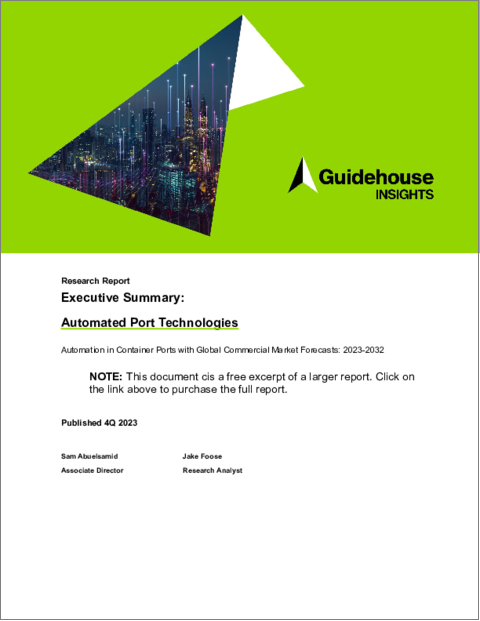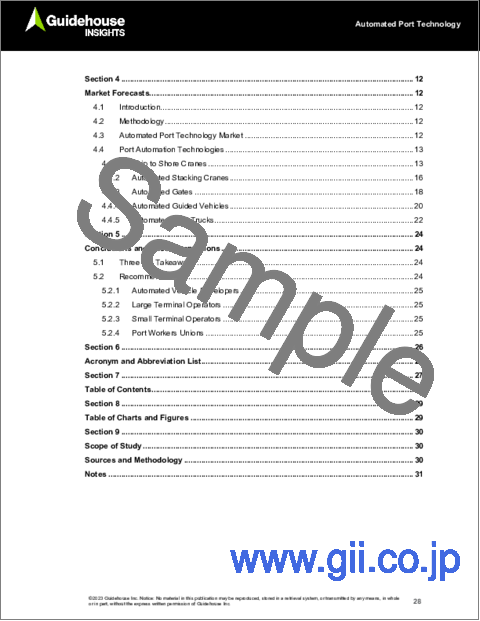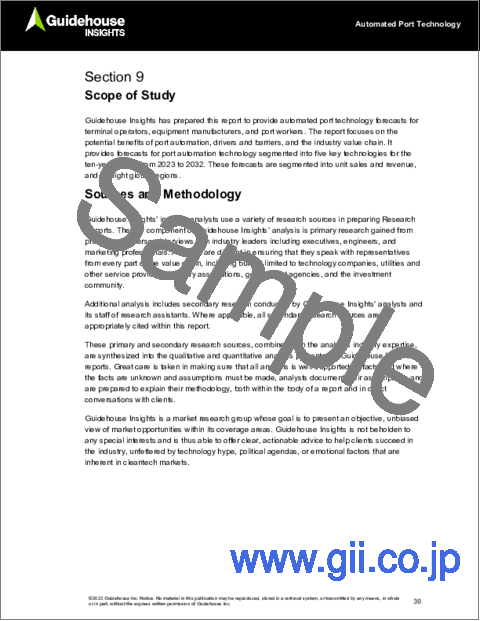|
|
市場調査レポート
商品コード
1389912
自動港湾技術Automated Port Technologies: Automation in Container Ports with Global Commercial Market Forecasts, 2023-2032 |
||||||
|
|||||||
| 自動港湾技術 |
|
出版日: 2023年12月04日
発行: Guidehouse Research
ページ情報: 英文 33 Pages; 25 Tables, Charts & Figures
納期: 即納可能
|
- 全表示
- 概要
- 目次
世界の物資の80%以上が海上輸送で、その多くが海上コンテナで運ばれています。その結果、コンテナ港湾は世界経済にとって重要なイネーブラーであると同時に、ボトルネックでもあります。2020年、COVID-19パンデミックの際には、このことがはっきりと浮き彫りになっています。このとき世界は、世界経済のどれだけの部分がこの海運方法に依存しているか、そしてそれがいかに早く頓挫するかを目の当たりにしました。港湾は、国際的サプライチェーンの強化に取り組む企業にとって、重要な拠点です。
他の産業がその構成プロセスを自動化し始める中で、自動化の安全性・効率性・持続可能性に関する利点が見出されています。コンテナ港湾ターミナルがこのプロセスに着手していますが、まだ広範囲に自動化が浸透してはいません。その要因の一つとして、市場がまだ発展途上にあることが挙げられますが、もう一つには、他の産業での自動化の利点の一部がコンテナターミナルで発揮されていないことも挙げられます。
当レポートでは、世界の自動港湾技術の市場について分析し、技術の概略や今後の発展見通し、港湾自動化の潜在的利点、主な普及促進・抑制要因、業界のバリューチェーンなどを調査すると共に、5種類の主要技術の今後10年間の市場動向の見通し (販売台数・収益額など、2023年~2032年) や、地域別の詳細動向 (全8地域) を予測しております。
目次
第1章 エグゼクティブサマリー
第2章 市場の問題
- 促進要因
- 効率性
- 排出削減
- 健康・安全
- セキュリティ
- 抑制要因
- 非効率な費用便益分析
- 港湾のワークフロー
- 実証されていない利点
- 価格設定
- その他のビジネス上の問題
第3章 業界のバリューチェーン
- 港湾での動きの概略
- 荷揚げ
- ドックヤード
- コンテナの移動
- 出航
- 競合情勢
- バリューチェーンの図解
- ビジネスモデルの進化
第4章 市場予測
- イントロダクション
- 調査手法
- 自動港湾技術の市場
- 港湾の自動化技術
- 荷揚げ用クレーン
- 自動スタッキングクレーン
- 自動化ゲート
- 無人搬送車 (AGV)
- 自動ヤードトラック
第5章 結論・提言
- 3つの大きなポイント
- 推奨事項
- 自動運転車の開発者
- 大規模ターミナルのオペレーター
- 小規模ターミナルのオペレーター
- 港湾労働組合
第6章 頭字語と略語のリスト
第7章 目次
第8章 図表一覧
第9章 分析範囲
第10章 出典、分析手法、メモ
More than 80% of the world's goods are carried by sea, and much of it in shipping containers. As a result, container ports are both a significant enabler and a bottleneck for the global economy. In 2020, this was put in stark focus during the COVID-19 pandemic, when the world saw how much of the global economy relies on this method of shipping, and how quickly it can be derailed. Ports represent a focus for anyone looking to harden the global supply chain.
As other industries have begun to automate their component processes, they have found benefits in safety, efficiency, and sustainability. Container port terminals have begun this process but have yet to adopt automation on a wide scale. This is partially due to the nascency of the market, and partially because some of the benefits of automation in other industries have not played out in container terminals.
This Guidehouse Insights report provides automated port technology forecasts, the potential benefits of port automation, drivers and barriers to adoption, and an industry value chain. It provides forecasts for port automation technology segmented into five key technologies for the ten-year period from 2023 to 2032. These forecasts are segmented into unit sales forecasts, revenue forecasts, and by eight global regions.
Table of Contents
1. Executive Summary
- 1.1 Market Overview
- 1.2 Scope
- 1.3 Market Forecast
2. Market Issues
- 2.1 Drivers
- 2.1.1 Efficiency
- 2.1.2 Emissions Reduction
- 2.1.3 Health and Safety
- 2.1.4 Security
- 2.2 Barriers
- 2.2.1 Inefficient Cost Benefit Analysis
- 2.2.2 Port Workflows
- 2.2.3 Unproven Benefits
- 2.3 Pricing
- 2.4 Other Business Issues
3. Industry Value Chain
- 3.1 Port Movement Explained
- 3.1.1 Ship to Shore
- 3.1.2 Dock Yard
- 3.1.3 Container Movement
- 3.1.4 Exiting the Port
- 3.2 Competitive Landscape
- 3.3 Pictorial Representation of the Value Chain
- 3.4 Business Model Evolution
4. Market Forecasts
- 4.1 Introduction
- 4.2 Methodology
- 4.3 Automated Port Technology Market
- 4.4 Port Automation Technologies
- 4.4.1 Ship to Shore Cranes
- 4.4.2 Automated Stacking Cranes
- 4.4.3 Automated Gates
- 4.4.4 Automated Guided Vehicles
- 4.4.5 Automated Yard Trucks
5. Conclusions and Recommendations
- 5.1 Three Big Takeaways
- 5.2 Recommendations
- 5.2.1 Automated Vehicle Developers
- 5.2.2 Large Terminal Operators
- 5.2.3 Small Terminal Operators
- 5.2.4 Port Workers Unions






